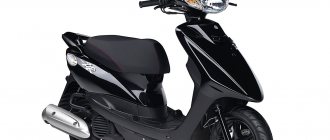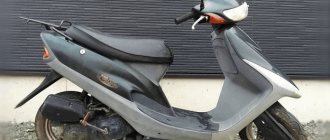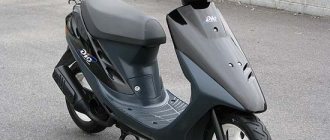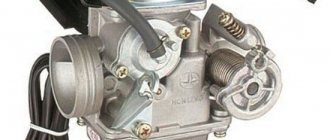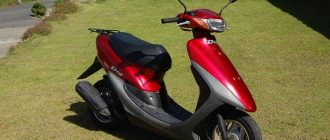Honda Today are stylish, modernized scooters of a new generation, which are characterized by consistently high quality, presentable, bright design, and excellent technical parameters. The models went on sale in 2002. Both beginners and advanced racers can operate the vehicle. You can ride a scooter on city streets and unpaved roads. At first glance, you are attracted by the original, extraordinary appearance of the product, which combines features of modern and retro style. Honda Today successfully stands out from other models from the wide range of scooters from the Japanese manufacturer.
Review and technical characteristics of the scooter
The Honda Today scooter is equipped with a single-cylinder four-stroke engine, which allows you to make daily trips around the city in comfort. The engine is quite powerful (4 hp at 8000 rpm), air-cooled and capable of reaching speeds of up to 60 km/h. The engine capacity is 49 cm3, which allows you not to register the vehicle with the traffic police and drive a scooter without a category A1 license. Both front and rear brakes are drum brakes. Today is available in pink, red and blue colors.
The Honda Today af61 has the following advantages:
- Stylish design. The '80s-inspired look will turn heads on the road. In addition, retro is now back in trend, which means that a scooter can become not only a means of transport, but also a fashion accessory.
- Aerodynamics. Decorative plastic gives the scooter the ability to better cut through air flow, which has a positive effect on fuel consumption.
- Ride comfort. In addition to the fact that the scooter owner does not have to constantly change gears, the soft suspension and characteristic landing provide maximum riding comfort.
Of course, a scooter accelerates slower than a moped due to the smaller wheel diameter, which should also be taken into account. In addition, small wheels spin faster, which can be dangerous for skidding on wet pavement.
Fighters of an almost invisible front (Honda Today)
Similar machines are produced in three countries, besides Japan - in France, Russia and Switzerland. In the first two cases, their appearance is justified by law. In Japan, microcars have tax breaks upon purchase (3% of the cost versus 6% for “normal” cars), they are allowed garage-free storage (when purchasing a “normal” car, documentary evidence is required that there is somewhere to park it), and some parking restrictions. In France, they are allowed to be driven without a license and stopped under a “no stopping” sign. In Russia, Oka is made as always, either out of sly concern for the population, or out of a misunderstanding, and the Swiss-German Smart is apparently produced out of good will for reasons of general crowding on the streets of Europe. To one degree or another, the “overpopulation” of cars on the streets of megacities is the main reason for their existence as a result of the adoption of laws encouraging this.
In Japan, microcars (where this class is officially called micromini) are produced by all manufacturers except Toyota, Nissan and Isuzu. The Honda Today II sample we examined was produced at a time when a “preferential” car had to fit into a parallelepiped 3300 mm long, 1400 mm wide and 2000 mm high, and the engine had a volume of no more than 660 cc. see. True, this bar was periodically raised. Initially it was 3 meters long, 1.3 wide and 360 “cubes”. Since 1976, these sizes no longer suited even the slender Japanese, and the limit rose to 3.2, 1.4 and 550. In 1990, the characteristics became 3.3, 1.4 and 660. And the last relaxation was made in 1998 year, but only in terms of dimensions - the length reached 3.4 and the width 1.48 meters. The share of such cars in production in Japan is from 4 to 5%, and Honda has about 13% in this segment.
The history of microHonda begins in 1967 with the advent of the N360 2-door sedan with a 2-cylinder air-cooled engine producing 31 hp. Then the LN360 hatchback appeared. The base of these machines was exactly 2 meters. In 1970, the 3-door Z coupe was released on the platform of the second generation of the N series. The motorcycle engine capacity allowed them to spin up to 9000 rpm. In 1971, a new Life family was released with a “water” engine with two carburetors and 36 hp. and immediately in three modifications of pleasant body shapes - 2 and 4-door sedans and a 2-door station wagon. The wheelbase increased by 8 centimeters compared to the N. A year later, the model acquired a unique “hardtop” body for such a small size - without a B pillar, and in 1974 the company stopped producing microminis, as it focused on producing the “full-size” Civic model. However, at that time it was not much larger than these babies - its wheelbase was only 220 cm. This is less than the Today, with which Honda returned to the “Lilliputian” class in 1985. The base was as much as 233 cm, and until 1988 it was driven by a 550 cc 2-cylinder engine, after which it was replaced by a 3-pot with 4 valves per cylinder. And in 1990, with the introduction of new requirements, it received a 660 cc engine, as well as new oval headlights, taillights, bumpers, independent rear suspension and all-wheel drive modification. The body was unique - a 3-door sedan. You will find out what it is if you can finish reading. In 1991, the Beat microsupercar was made on its basis with a 3-cylinder engine located transversely behind the seats, producing 64 “horses” without supercharging from 660 cubes. It remained on the production line until 1996.
The second generation of Today was born in 1993 and technically represented the latest modernization of the first generation, dressed in a new elegant body. Moreover, a 5-door sedan version appeared. The 5-door Life, revived on the basis of Today in 1997 in the back of a microvan, ousted its progenitor from the production line a year later. After just a year and a half, Life was modernized in accordance with the newly changed norms. The wheelbase increased to 236 cm, and an all-wheel drive version and a 5-link rear suspension appeared. And at the end of 2000, the engine in the Dunk modification acquired a turbine. In addition, in 1998, the Z was revived again in the form of a micro-SUV with an engine located under the rear seat, which could be with a turbine. The year 2002 completes our excursion with the end of the release of the Z and the beginning of the latest micromini model, That's, technically identical to the Life, but more refined aesthetically and 15 centimeters taller.
In Russia, Japanese microcars are a rare exclusive. It's hard to say what motivates the people who buy them. Due to their intended use for the domestic market, the parts are mostly original, and the difference in the price of the car itself is not so significant compared to just compact cars like the Toyota Corolla II or Nissan March, and the safety margin is correspondingly lower. But nevertheless they find their fans. Maybe it's because of fuel economy, space, or just because they're original.
For example, this example of a microcar is a clear example of the fact that the design and construction of such a car can be done not according to the residual principle - just to squeeze the seats into a yogurt jar with a motor limited by strict dimensions. This is by no means a primitive “disabled woman” with a simple design. The eye will immediately notice the wheels scattered as far as possible from each other - both in the track and in the base. The front part resembles a Renault Twingo and the face of a puppy - if you look closely, it seems to be built around a wheel. More precisely, the theme of the circle that it sets. Round headlights, fog lights, side turn signals, rounded turn signals in the bumper. You'd expect this theme to dominate the design of the entire car, but it doesn't. Quite unexpectedly, the rear lights turn out to be the usual rectangles, and another theme sets the tone in the body profile - a rear pillar with a “reverse” slope. As a result, the side windows give the body a wedge-shaped shape. This is how the solutions found by the designers of modest models are usurped by others, more noticeable - and we gave the palm in this touch to the Toyota Ipsum/Picnic and Mercedes A-Class. Moreover, this detail is inherent only in the 3-door sedan; in the 5-door sedan, the sidewall is completely prosaic.
So what is a 3-door sedan? At first glance, the body seems to be one-volume, but upon closer inspection you notice the “tail” of the trunk, slightly disguised by this rack and spoiler. Now let's try to open this trunk. No, not the way you want to do it reflexively. And like the side of a pickup truck - down. That's all. The glass remains in place, and the “secret door” is held horizontally by cables. Opening it, you will see a small “closet” with a volume equivalent to 120-130 liters. If there is a need, you can recline the back of the rear seat directly from the trunk, and the volume will increase five times, but you can only load something bulky through the front door, and only long-length items through the “hatch.”
Side impact protection beams are inserted into the door design, so you don't feel completely defenseless in this small enclosed space. Although I didn’t feel disadvantaged in the car with my height of 190 cm - the front half of the cabin was laid out very competently. Of course, it is better to seat smaller passengers in the back. The interior is simple but intricate. The upholstery of the doors and seats is two-tone with motley blue fabric inserts, but mixed with lifeless gray plastic. The front dashboard has been designed in an interesting way - the continuation of the instrument panel is a climate control unit, and then a voluminous glove box with a hinged lid-stand. On occasion, if you are looking for something, you can put this “mess” on this lid. And below it there is a “glove” shelf. The package includes an electrical package - power windows and mirrors, as well as central locking, air conditioning with economy mode, radio with remote control, fog lights. Additional equipment may include an airbag for the driver and ABS. The front brakes are discs, the rear are drums. There are also modifications with all-wheel drive operating in Real time mode, that is, the rear wheels engage when the front wheels slip. The transmission can be selected from a 5-speed manual or a 3-speed automatic, as on this car.
Honda wouldn't be Honda if it didn't do something special with the engine. This 3-cylinder, 12-valve, single-shaft injection engine is equipped with MTREC. Which stands for Multi Throttle Responsive Engine Control, which in turn translates as multi-throttle engine control with feedback. Each cylinder has its own throttle body and intake manifold, and the electronic control monitors throttle position, gear engaged and driving speed. You can figure out how this works if you wish, but as a result it is possible to increase power to 58 “horses” at 7300 rpm and torque to 60 kilograms versus 48 at 6300 and 57 for a similar engine without such a system.
What does this give? Surprisingly, we expected greater agility with such, in general, not weak characteristics with a machine weighing 660 kg (coincidence - the figure corresponds to the volume). Acceleration seems to have started quite actively, but the pedal has very little travel and has already reached the extreme position. The gear shifts with a noticeable but smooth push, and again the pedal “rests” almost immediately. Maybe you need to drive for a while so that the feedback “reads” your driving style and corrects it just like on serious cars with adaptive automatic transmissions. This seems incredible, but apparently it is true. And the most curious thing is that it is the engine that changes the characteristics, not the gearbox. Unfortunately, there was not enough time to verify this.
The trip to Today did not bring any special sensations. The car rolls noticeably when cornering, and the suspension, with all its desire and “independence,” cannot patiently endure the abuse of our roads and reports this with sound and body shocks. Don’t think that they are so annoying; there is no desire to get out of the car. They exist, a miracle did not happen, but these are not pitiful groans, but through clenched teeth the groans of a young warrior enduring pain - a descendant of samurai. But the brakes are extremely informative, giving a feeling of confidence. Actually, that's all. A good vehicle for unspoiled but dignified people, with absolutely no age restrictions. By the way, Honda has another Today. Minimokick.
2004
Operation, maintenance and repair
Honda Today is a fairly repairable scooter. All that needs to be done to get to the main components is to remove the decorative plastic, but if the plate itself was damaged, the part will have to be completely replaced. Servicing a variator also costs a certain amount, and not everyone can repair it. By the way, Honda Today is absolutely not afraid of moisture, because all the main components are reliably protected from water by plastic.
In order for a scooter to serve for a long time and trouble-free, it is important not only to be able to repair it, but also to ride in such a way that repairs are required as rarely as possible. New equipment must be tested before everyday use. The running-in period of the Honda Today literally determines the future fate of the scooter, because it allows you to get used to the operating features of the engine and main components. During break-in, do not heavily load the scooter and ride with the throttle fully raised. These recommendations should be followed during the first 1000 km of driving, so as not to deteriorate the performance of the Honda Today in the future.
Buying Honda Today
Japanese scooters have proven themselves well in the market. There is no doubt about their quality and reliability. The units are able to withstand extreme operating conditions, and their service life, if correct and timely maintenance is provided, reaches several decades. Powerful, maneuverable, easy to drive, beautiful Honda Today is quite expensive in showrooms. Transport costs, customs, taxes, surcharges, as a result, the price of motor vehicles significantly exceeds the real cost.
Buying used Japanese scooters on the website https://kupiscooter.ru/ is fast, convenient, and profitable. The catalogs present a wide range of vehicles, including Honda Today, Yamaha Jog, Suzuki Mollet and others. These are not metal scooters, these are efficient, reliable, functional scooters, the cost of which is significantly lower than the market price. On the website you can familiarize yourself with the technical characteristics of the models, prices, photos, and terms of purchase.
Specifications
| Model | Today BA-AF61 FI/E (Honda Today AF 61) |
| Length | 1.695 m |
| Width | 0.630 m |
| Height | 1,030 m |
| Weight, kg | 75 (dry weight 71 kg) |
| Capacity | 1 person |
| Fuel consumption | 65 km/l (at 30 km/h) |
| Minimum turning radius | 1.8 m |
| Engine | 4-stroke air-cooled, single cylinder |
| engine's type | AF61E |
| The full amount | 49 cm 3 |
| Bore × stroke | 37.8 × 44.0 mm |
| Compression ratio | 10,1 |
| Maximum output power | 2.8 kW (3.8 hp) at 8000 rpm |
| Torque | 3.6 N*m (0.37 kg*m) at 6500 rpm |
| Fuel supply form | Carburetor VK00A |
| Starting system | Electric starter and kick starter |
| Ignition | CDI |
| Lubrication | Separation by lubricant |
| Fuel tank volume | 5.0 l |
| Clutch | Dry multiplates |
| Transmission type | CVT (V-Matic belt) |
| Tires (front and rear) | 80/100-10 46J |
| Brakes (front and rear) | Mechanical drum |
| Suspension type (front) | Telescopic |
| Suspension type (rear) | Spring |
Operation, maintenance and repair
The operating instructions for the Today scooter can be downloaded from the link:
Replacing consumables
During operation, metal dust settles in the engine oil, which affects the structure and properties of the oil. That is why it must be replaced regularly. The first change is carried out immediately after purchase. The second is recommended after 1000 km, and after break-in - 3-4 thousand km.
Oils typically used range from SAE 5W-20 to 10W-40. A worn engine will accept SAE 20W-50 grade oil.
Before replacing, warm up your moped. This will thin the oil and mix it with any dirt that may have accumulated in it. To warm up a moped in summer, 5 minutes is enough, in winter – 10 minutes.
Ignition installation
The Honda af61 uses a CR7HSA spark plug with a resistor. To install the ignition, follow the instructions:
- Disconnect the spark plug cable;
- Connect two strobe wires to the battery and the third to the spark plug cap;
- Find the ignition timing timing marks (usually one mark on the generator flywheel, the second on the scooter body);
- Crank the engine and fix the strobe flash and markers. If the response time of the device coincides with the marks on the power unit, then the ignition is set correctly.
What is the price
In Ukraine, a Honda today af61 moped costs from 9,378 to 15,630 hryvnia. 2 year warranty. Delivery is free.
In Russia, this model can be bought from 18,000 to 65,000 rubles. Warranty and return by agreement with the client. There is no delivery - you will have to pick up the transport yourself. Payment can be made in cash or to a Sberbank card.
This is a modern scooter model that has a retro design. A four-stroke air-cooled engine is installed. It can reach a maximum speed of 60 km/h, the engine capacity is 49 cubic meters. cm, the fuel tank holds 5 liters. A drum brake system is installed. Judging by the reviews, the owners liked the model for its appearance, reliability, driving performance, comfort, and safety.
Among the shortcomings, it should be noted that for country roads there is a very insufficient softness of the suspension, and the average dynamics are also disappointing. Advantages include comfortable seating, low fuel consumption, and attractive design. This scooter is suitable for beginners and is very comfortable to drive. After a run of 1500 km you need to change the oil. The scooter rides quite silently. The owners note that the scooter’s parts are protected from moisture, and all components are hidden in high-quality plastic.
The price of the model is a little high, but this is explained by the excellent Japanese quality. Judging by the reviews, you can ride it for three years without any problems. The model has excellent traction and is good for driving uphill. The owners are particularly pleased with its rare appearance and the modern spare parts installed inside.
| Description Scooter HONDA TODAY AF67 | |
| Engine capacity (cm. cubic meters) | 49 |
| Engine capacity (cm. cubic meters) | up to 50 cm3 |
| engine's type | Four stroke |
| Transmission | variable speed drive |
| Number of cylinders | 1 |
| Maximum power (hp/rpm) | 4,1 / 8250 |
| Fuel tank capacity (litre) | 5 |
| Piston bore and stroke (mm) | 37,8×44,0 |
| Starting system | electric start kickstarter |
| Ignition system | cdi |
| Cooling system | air |
| Front brake type | drum |
| Rear brake type | drum |
| Overall dimensions LxWxH (mm) | 1695*630*1030 |
| Ground clearance (mm) | 110 |
| Wheelbase (mm) | 1180 |
| Front wheel size (mm) | 80 |
| Rear wheel size (mm) | 80 |
| Dry weight (kg) | 71 |
| Seat height (mm) | 695 |
| Number of seats | 1 |
| Luggage compartment under the seat | Yes |
| Case | No |
| Color | pink, red, blue |
Video review of the HONDA TODAY AF67 scooter
Honda Today
The Japanese scooter Honda Today (Today) is a modern scooter with an attractive design, made in the retro style that is popular today
This moped perfectly combines the beautiful shapes of yesteryear and modern technologies embodied in the design of the engine, transmission and chassis.
The optimal combination of vintage design and modern, economical engine allows Honda Today to be on the list of the most popular scooters with an engine capacity of up to 50 cm3. This is one of the most successful symbioses of new technologies and a beautiful shell with smooth lines from the 60s. The Honda Today scooter belongs to the class of modern retro scooters with good technical characteristics and an attractive design. This device is suitable for almost any driver, be it a beginner scooter rider or a pilot with extensive driving experience. The moped is very simple and easy to use, it steers and brakes well. A comfortable anatomical seat and powerful light will add comfort both on long trips and short city runs.
The motor on this device is not the simplest, but quite reliable. The four-stroke air-forced-cooled engine does not require any special or frequent maintenance. It is quite enough to carry out a scheduled oil change and replace the spark plug. The engine operates without any problems at any speed and under any load.
The moped suspension is the most standard for its class. At the front there is a telescopic wishbone suspension with a long stroke, at the rear there is a reinforced monoblock made of a powerful spring and a gas-oil shock absorber. This combination gives the scooter increased ground clearance, which has the best effect on the cross-country ability of this vehicle.
Thanks to the aluminum frame, the Honda Today scooter is lightweight and has excellent handling at any speed.
Classic brakes confidently and adequately stop the moped on any road surface. The drums on all wheels are very durable and reliable. This is especially noticeable in rainy weather on washed-out roads.
As for the design and interior, everything here is done “in the Japanese way”, nice and neat. Ergonomics are at the proper level: every button or switch is in its place, no innovations or innovations. The head light deserves special attention: a large and powerful headlight allows you to easily control the scooter even in complete darkness.
You can buy this scooter inexpensively in our stores located in convenient places in Moscow. If necessary, equipment is delivered using the company’s own transport or third-party carriers.


